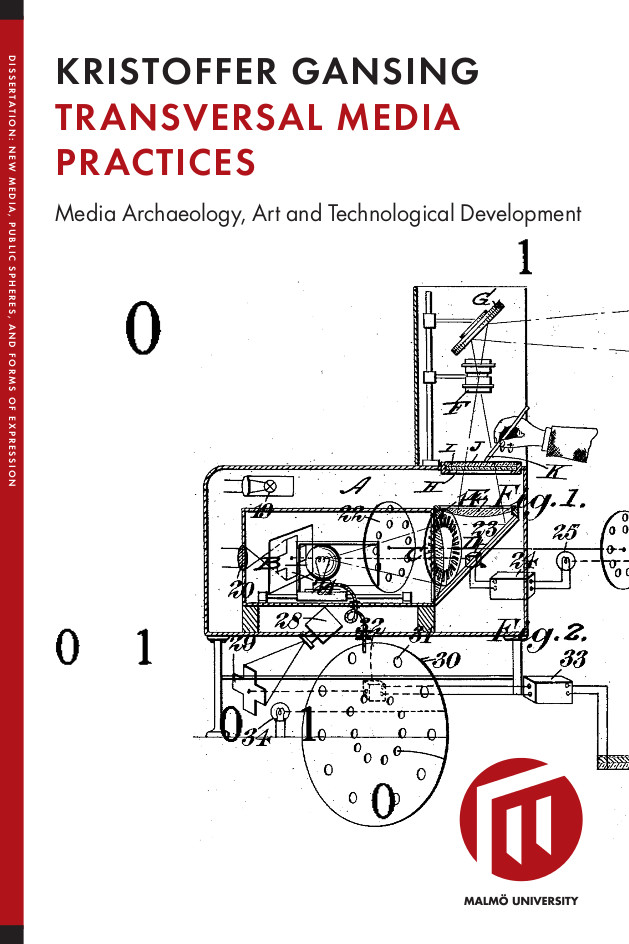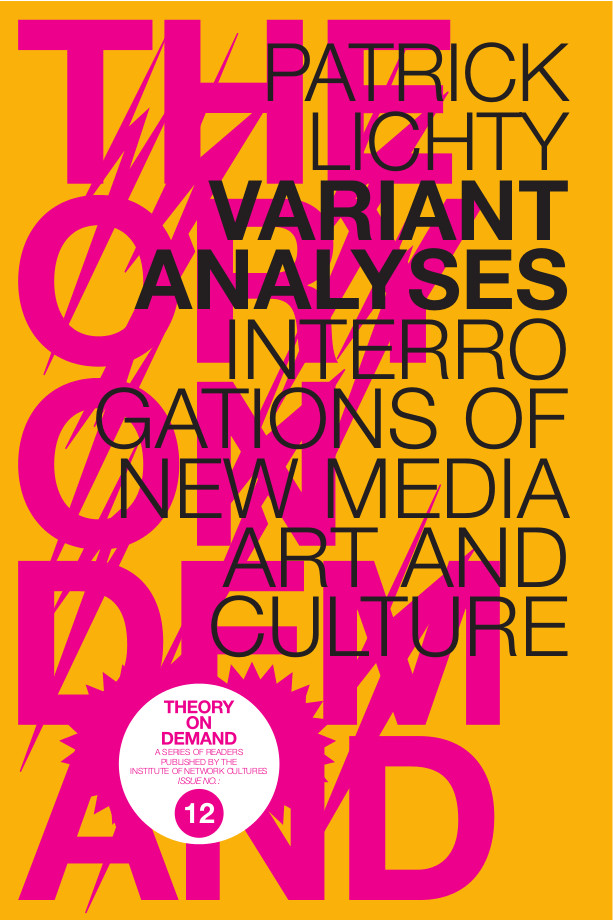Kristoffer Gansing: Transversal Media Practices: Media Archaeology, Art and Technological Development (2013)
Filed under thesis | Tags: · art, artistic research, imagination, media archeology, media art, new media, overhead projector, remediation, technology, television, transversality

“Transversal Media Practices work across specific situations of technological development, critically examining and redefining the terms of production in different media by bringing heterogeneous histories, institutions, actors and materialities into play with one another. This dissertation is all about trying out and refining the methodologies of such transversal media practices, in the end outlining a conceptual set of tools for further development.
Following the technological hype of the “digital revolution” of the mid-1990s, the field of new media studies gained popularity over a ten year period. This dissertation takes its cue from a historical turn in new media theory, and argues that it is time leave behind strict polarisations between old and new as well as analogue and digital. The study unfolds through two case-studies. The first, “The World’s Last Television Studio”, looks at tv-tv, an art and media-activist project that negotiates the sociocultural and material changes of the “old” and institutionalised mass medium of television. In the second case study, “The Art of the Overhead”, another old medium is engaged: the overhead projector – a quintessential 20th century institutional medium here presented as a device for rethinking the new through the old. The problematic of technological development, i.e. dealing with questions of how (media) technologies develop over time, forms the background to these two case studies. A key issue being how cultural and artistic practices dealing with the interaction of old and new media invite us to conceptualise technological development in new ways.
The emerging field of media archaeology is employed as a methodology in media studies and cultural production, comprising a theoretical and applied analysis of media history, materiality and practice. This transversal approach allows media archaeologists to deal with the relation between the old and the new in a non-linear way as well as to pay attention to the technical materiality of media. It is argued that the transversality of the media-archaeological approach should be seen in contrast to other conceptions of media history and technological development, such as progressivist, mono-medial and evolutionary ones. In this study, the author tries out the potential of media archaeology to reform our conception of media technologies, and eventually formulates a set of concepts for thinking and doing media archaeology as a transversal media practice. These tools are about the imaginary, residual and renewable dimensions of media technologies and are meant to assist in the opening up and intervening into processes of standardised media development.
On a general level the resulting set of tools for transversal media practices builds a bridge between theory and practice: they can be used for further research and cultural analysis where objects of study speak back to analytical concepts. At the same time these are tools for transversality that expand this form of cultural analysis in that the travelling between disciplines here also means a travelling between theory and practice. On a specific level, the tools enable this travel between theory and practice in media- and communication studies, and as such they contribute to the development of new practice-based methodologies in media research.”
Doctoral dissertation in Media and Communications Studies
School of Arts and Communication, K3; Faculty of Culture and Society; Malmö University
Dissertation series in New Media, Public Spheres and Forms of Expression
Creative Commons Attribution-NonCommercial 3.0 Unported License
ISBN 9789171044815
350 pages
Publisher
Media archaeology on Monoskop wiki (incl. source bibliography)
PDF, PDF (updated on 2025-11-25)
Comments (3)Alex Sayf Cummings: Democracy of Sound: Music Piracy and the Remaking of American Copyright in the Twentieth Century (2013)
Filed under book | Tags: · copyright, counterculture, intellectual property, law, music, new media, phonograph, piracy

“It was a time when music fans copied and traded recordings without permission. An outraged music industry pushed Congress to pass anti-piracy legislation. Yes, that time is now; it was also the era of Napster in the 1990s, of cassette tapes in the 1970s, of reel-to-reel tapes in the 1950s, even the phonograph epoch of the 1930s. Piracy, it turns out, is as old as recorded music itself.
In Democracy of Sound, Alex Sayf Cummings uncovers the little-known history of music piracy and its sweeping effects on the definition of copyright in the United States. When copyright emerged, only visual material such as books and maps were thought to deserve protection; even musical compositions were not included until 1831. Once a performance could be captured on a wax cylinder or vinyl disc, profound questions arose over the meaning of intellectual property. Is only a written composition defined as a piece of art? If a singer performs a different interpretation of a song, is it a new and distinct work? Such questions have only grown more pressing with the rise of sampling and other forms of musical pastiche. Indeed, music has become the prime battleground between piracy and copyright. It is compact, making it easy to copy. And it is highly social, shared or traded through social networks–often networks that arise around music itself. But such networks also pose a counter-argument: as channels for copying and sharing sounds, they were instrumental in nourishing hip-hop and other new forms of music central to American culture today. Piracy is not always a bad thing.
An insightful and often entertaining look at the history of music piracy, Democracy of Sound offers invaluable background to one of the hot-button issues involving creativity and the law.
– Provides a political and historical perspective on the rise of the “information economy.”
– Discusses rare and little-known unreleased songs by the Beatles, which are potentially controversial because of their racial content.
– Shows how piracy has been integral to the music industry through much of its history and how pirates have influenced copyright law.”
Publisher Oxford University Press, 2013
ISBN 0199858225, 9780199858224
336 pages
Patrick Lichty: Variant Analyses: Interrogations of New Media Art and Culture (2013)
Filed under book | Tags: · activism, media art, new media, new media art

Lichty’s range of commentary and analysis dissects nearly two decades of what has now become new media society. Before Facebook’s IPO and Wikileaks’ media storm, artist-as-activists experimented with data gloves, virtual world performance, and anonymous, anarchic disruptions determined to bewilder traditional enclaves of art and political society. In this collection Lichty presents several such experiments in distributed creativity: collaborations across a range of technologies and platforms, where authorship becomes a vague placeholder and sometimes acts as a performance in of itself, and the artwork is equally in flux, always in process, and often disappearing into bits.
These essays provide an extensive and timely overview of critical thought on new media culture, written by an observer-participant who has made major contributions to the sociopolitical movements he archives. Spanning art and new media theory, activism and literary criticism, this assembly seeks to understand the networked society in flux: what it means when the virtual integrates with the physical, and when newer, uncategorized media works prompt major shifts in cultural production and change the very definition of art and protest. As a veteran observer of the technological society, Lichty has produced the ideal guidebook for exploring the wilderness of our digital mediascapes, both past and present.
Publisher Institute of Network Cultures, Amsterdam, April 2013
Theory on Demand series, Vol. 12
Creative Commons Attribution Noncommercial No Derivative Works 3.0 Netherlands License
ISBN 9789081857543
169 pages

